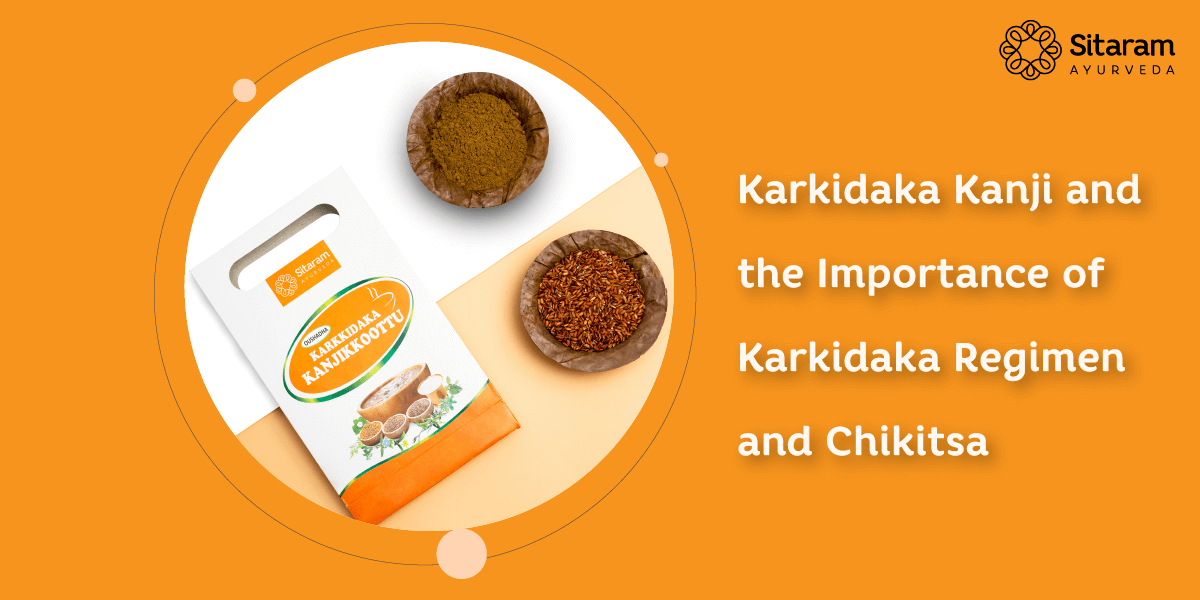KARKIDAKA REGIMEN

The solar calendar used in Kerala, Andhra Pradesh and Karnataka follows a pattern of six seasons – Sisira, Vasantha, Greeshma, Varsha, Sarad and Hemanta. Each season being two months, they coincide with the Gregorian Calendar months from December to November respectively. The month of Karkidaka extends from mid July to mid August and marks the transition from the hot and humid monsoon to the cooler days of Sarad rtu.
In the extreme heat of Greeshma, Vata dosha undergoes ‘chaya’ or a state of precipitation of its noxious properties. The abrupt cooling and humidity brought about by the monsoon pushes the vata to manifest in all its deranged glory. The body is plagued by aches and pains, rigidity, fraility and weakness; the digestive fire becomes debilitated; the person loses health and vigor.
Forseeing this turn of events, the Karkkidaka regimen came into vogue in the southern parts of Indian, particularly Kerala. Being a period of heavy rainfall, people are encouraged to invest in their physical, mental and spiritual well being. Ayurveda, the native system of healing steps in to cater to the needs of the body during this period. Simple diet and lifestyle modifications, combined with ‘oushadhaseva’ or systematic intake of Ayurvedic medicine, endows the body with excellent immunity and renewed health and vigor.
The Karkkidaka month demands a healthy regimen of early waking, an indulgent bath with oil massage and warm water, easy to digest meals and an early bedtime. This placates the vata that has been provoked by the climatic changes. Abhyanga, the practice of massaging the body with warm medicated oil, counters the dryness, rigidity and pain brought on by Vata imbalance. It is grounding and calming to the senses, and refreshing to the mind and body. Sahacharadi taila, Dhanwantaram taila, Kottamchukkadi taila etc are some common tailas used.
It is a practice among the elderly to steady the body with ‘vata’hara’ decoctions like Chuvannaratha kashaya, Dhanwantaram kashaya or Ashtavarga kashaya during this period. The degeneration and weakness manifest in the muscles, bones and tissues is compensated for, as a part of Karkkidaka chikitsa.
Strenous activity and mental exertion are not encouraged during this period. Instead, people are encouraged to take up spiritual pursuits like the reading of religious scriptures to invoke the ‘Satwik’ nature of the mind. Day sleep and exposure to extremes of heat and cold are strictly contra-indicated.
It is a healthy practice to fumigate the house at dusk. This cleanses the living space and stops the spread of diseases. The obvious need for protective footwear and umbrella is to be kept in mind.
Stoke the digestive fire, keep it burning – is the principle behind the Karkidaka diet. Indigestion, heart burn, adbominal gas and flatulence, lethargy and lack of appetite are red flags put up by a dwindling ‘Jatharagni’ or digestive fire.
Light, unctous, easy to digest meals comprising of rice gruel, lightly seasoned vegetable soups and goat meat soups, green gram etc are healthy choices. The practice of partaking ‘Patthila’ or the ‘ten leaves’, during the month of Karkidaka, points to the need for a fibre rich diet that cleanses the gut. However, excessive consumption of raw vegetables and leaves as salads is not at all advocated, as it again upsets the ‘vata’ in the gut.
Good bowel movement is of paramount importance in balancing ‘Vata’. Warm and unctous meals, supplemented with herbal combinations that assist in digestion and absorption are recommended. Ashtachoorna, Dadimashtaka choorna, lightly spiced buttermilk and Mukkudi (a preparation of buttermilk processed with peppers, ginger, turmeric, cumin, ajwain, and other spices) are all simple means to ensure perfect digestion and metabolism.
Karkidaka Kanji – The Supper for Health.
The systematic consumption of Karkidaka kanji or gruel during this period is a tradition that has stood the test of time. It is basically an easy-to-digest gruel of njavara, enriched with herbs and spices. The kanji is taken as supper or early dinner for a period of 7, 21 or 42 days, as per the convenience of the person.
Ingredients
| Njavara Rice | 50gms |
| Coconut Milk | 70-100ml |
| Oushadha Choorna | 7-10gms |
| Ghee, rocksalt, Indian shallots | For seasoning |
The Oushadha choorna consists of
| Malayalam name | Sanskrit name | Latin name |
| Jeerakam | Jeeraka | Cuminum cyminum |
| Kothamalli | Dhanyakam | Corriandrum sativum |
| Chukku Nagaram | Nagaram | Zingiber officinale |
| Kurumulaku | Maricha | Piper nigrum |
| Thippali | Pippali | Piper longum |
| Grampoo | Lavang | Syzigium aromaticum |
| Jathipatrika | Jathipatrika | Myristica fragrans |
| Elathari | Elam | Elettaria caradamomum |
Method of Preparation
- Boil njavara rice with sufficient quantity of water. When cooked half way, add the oushadha choorna and cook till perfect consistency of ‘kanji’ or gruel is obtained.
- Add 70-100 ml of coconut milk to the gruel. Simmer and switch off the flame.
- Add rock salt to taste. Finely chopped Indian shallots sauted in a tsp full of ghee may be added as a light seasoning.
- Have the gruel while still warm. Consumption of milk products, egg, fish and meat should be restricted or avoided totally if possible, during this period.
How to make Karkidaka Kanji
Benefits of Karkidaka Kanji Seva
- Pacifies vata in the gut, bones, muscles and joints.
- Cleanses the gut. Restores gut biome.
- Improves digestion and metabolism.
- Expels metabolic toxins from the body.
- Rejuvenates and regenerates


 Sign In
Sign In Cart
Cart